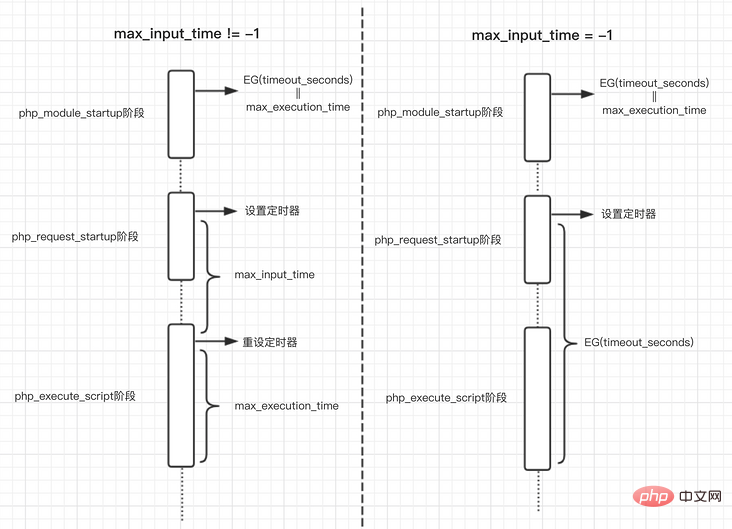Home >Backend Development >PHP Tutorial >A brief analysis of several timeout configurations in PHP configuration files
A brief analysis of several timeout configurations in PHP configuration files
- 青灯夜游forward
- 2022-03-09 11:21:235757browse
This article will talk about the PHP configuration file and analyze several timeout-related configurations in the configuration file (php.ini and php-fpm.conf). I hope it can help you!

1. Overview
There are many timeout-related configurations in php.ini and php-fpm.conf, so what exactly do these configurations do? How is it implemented in the source code? This article will talk about the following timeout configurations:
php.ini
- max_execution_time
- max_input_time
php- fpm.conf
- process_control_timeout
- request_terminate_timeout
- request_slowlog_timeout
##Running environment: Mac 10.14.2 PHP 7.3.7
2. Configure parsing rulesParsing rulesThe parsing of php.ini is completed in thephp_module_startup() stage, ini_entry is in The parsing rules defined for each php.ini configuration in main.c are in the following format:
ZEND_INI_ENTRY3_EX(name, default_value, modifiable, on_modify, arg1, arg2, arg3, displayer)PHP defines many macros for different types of configurations,
ZEND_INI_ENTRY3_EX is The final macro after they are expanded, such as PHP_INI_ENTRYMacro
PHP_INI_ENTRY(name, default_value, modifiable, on_modify)Parameter explanation
name: Configuration name
default_value: Configure the default value
modifiable: The configurable range of the configuration
These modes determine when and where a PHP command can be Whether it can be set. Each instruction in the manual has a mode to which it belongs. For example, some commands can be set in PHP scripts using ini_set(), while others can only be set in php.ini or httpd.conf. For example, the output_buffering directive belongs toPHP_INI_PERDIR, so it cannot be set with ini_set(). But the display_errors directive belongs to PHP_INI_ALL and can be set anywhere, including ini_set().
Mode Meaning ##PHP_INI_USER Can be set in a user script (e.g. ini_set()) or in the Windows registry (since PHP 5.3) and in .user.ini PHP_INI_PERDIR Can be set in php.ini, .htaccess or httpd.conf PHP_INI_SYSTEM Can be set in php .ini or httpd.conf set PHP_INI_ALL can be set anywhere on_modify: 配置修改函数
三、max_input_time、max_execution_time
因为
max_input_time和max_execution_time联系比较密切,所以放在一起来讲。php.ini 解释
max_input_time
; Maximum amount of time each script may spend parsing request data. It's a good
; idea to limit this time on productions servers in order to eliminate unexpectedly
; long running scripts.
; Note: This directive is hardcoded to -1 for the CLI SAPI
; http://php.net/max-input-time翻译过来就是:
max_input_time是每个脚本可以花在解析请求数据上的最大时间。在生产服务器上通过限制max_input_time可以清除掉长时间运行的脚本。在CLI模式下会硬编码为-1,即无限制。max_execution_time
; Maximum execution time of each script, in seconds
; http://php.net/max-execution-...
; Note: This directive is hardcoded to 0 for the CLI SAPI翻译:
max_execution_time是每个脚本的最大可执行时间。在CLI模式下硬编码为0配置解析规则
// max_input_time,默认值为无限制 STD_PHP_INI_ENTRY("max_input_time", "-1", PHP_INI_SYSTEM|PHP_INI_PERDIR, OnUpdateLong, max_input_time, php_core_globals, core_globals) // max_execution_time,默认值为30s,修改函数为OnUpdateTimeout PHP_INI_ENTRY("max_execution_time", "30", PHP_INI_ALL, OnUpdateTimeout)
OnUpdateTimeout()函数如下,由第二节可知配置解析发生在php_module_startup()阶段,此时EG(timeout_seconds)被赋值为了max_execution_time,但还没有设置定时器。// main.c static PHP_INI_MH(OnUpdateTimeout) { if (stage==PHP_INI_STAGE_STARTUP) { /* Don't set a timeout on startup, only per-request */ /* EG(timeout_seconds) = max_execution_time */ ZEND_ATOL(EG(timeout_seconds), ZSTR_VAL(new_value)); return SUCCESS; } zend_unset_timeout(); ZEND_ATOL(EG(timeout_seconds), ZSTR_VAL(new_value)); zend_set_timeout(EG(timeout_seconds), 0); return SUCCESS; }设置超时定时器
// main.c int php_request_startup(void) { ...... if (PG(max_input_time) == -1) { zend_set_timeout(EG(timeout_seconds), 1); } else { zend_set_timeout(PG(max_input_time), 1); } ...... } int php_execute_script(zend_file_handle *primary_file) { ...... if (PG(max_input_time) != -1) { zend_set_timeout(INI_INT("max_execution_time"), 0); } ...... }从上面代码可以看到,如果设置了
max_input_time(即值不等于-1,-1可以认为是在CLI模式下),在php_request_startup()阶段会设置一个定时器,超时时间为max_input_time;在php_execute_script()阶段会重新设置一个定时器,超时时间为max_execution_time。那么整个PHP脚本执行的最大执行时间就等于max_input_time+max_execution_time。如果没有设置
max_input_time的话(即值等于-1),在php_request_startup()阶段也会设置一个定时器,但超时时间被设为了EG(timeout_seconds),而EG(timeout_seconds)已经在php_module_startup()阶段被赋值为max_execution_time,所以此时的超时时间就是max_execution_time;在php_execute_script()阶段不会重新设置定时器,前一阶段设置的max_execution_time定时器仍然生效着。那么整个PHP脚本的最大执行时间就是max_execution_time。
zend_set_time()使用setitimer(ITIMER_PROF, &t_r, NULL);来实现定时器,ITIMER_PROF会统计包括用户态和内核态下所花费的时间,而像sleep()这样的系统调用会让进程挂起,不占用cpu时间片,所以这俩超时时间是不包括sleep()时间的。当定时器到时间后,ZendVM会抛出
E_ERROR,即Fatal error错误。四、process_control_timeout
php-fpm.conf 解释
; Time limit for child processes to wait for a reaction on signals from master.
; Available units: s(econds), m(inutes), h(ours), or d(ays)
; Default Unit: seconds翻译:
process_control_timeout是留给子进程处理来自master进程信号的时间限制。分析
当master进程接收到
SIGINT、SIGTERM、SIGQUIT、SIGUSR2这些信号时,会调用fpm_pctl()来进行处理。首先master进程会根据 接收到的信号 和 当前fpm的运行状态 来决定发送给worker进程的是
SIGQUIT还是SIGTERM信号,同时注册时间为process_control_timeout的定时事件。如果在
process_control_timeout时间内子进程没有退出,那么master进程会升级SIGQUIT为SIGTERM,SIGTERM为SIGKILL,并注册1s的定时事件。SIGKILL就直接终止worker进程了,SIGTERM还能再给worker进程1s的时间。综上,
process_control_timeout可以理解为master进程留给worker进程结束自己的时间,要是到时间worker还没搞定那就开始master自己的策略了。五、request_terminate_timeout、request_slowlog_timeout
因为
request_terminate_timeout和request_slowlog_timeout联系比较密切,所以放在一起来讲。php-fpm.conf Explanation
request_terminate_timeout
; The timeout for serving a single request after which the worker process will
; be killed. This option should be used when the 'max_execution_time' ini option
; does not stop script execution for some reason. A value of '0' means 'off'.
; Available units: s(econds)(default), m(inutes ), h(ours), or d(ays)
; Default Value: 0Translation: The timeout period for executing a request, after which the worker process will be terminated. This option should be used when
max_execution_timethis ini option cannot stop script execution for some reason.request_slowlog_timeout
; The timeout for serving a single request after which a PHP backtrace will be
; dumped to the 'slowlog' file. A value of '0s' means 'off' .
; Available units: s(econds)(default), m(inutes), h(ours), or d(ays)
; Default Value: 0Translation: Execute a request timeout, after which a PHP backtrace will be output to the slowlog file.
Analysis
request_slowlog_timeoutandrequest_terminate_timeoutare used in the heartbeat detection of the master process (fpm_pctl_heartbeat()) , the heartbeat timeheartbeatThe simplified algorithm is##The third rule is to ensure that slowlog does not affect normal requests,
When
request_terminate_timeoutis turned on:request_terminate_timeout/1000*3When
request_terminate_timeoutis not enabled:request_slowlog_timeout/1000*3or 0
request_terminate_timeout >= request_slowlog_timeoutheartbeat
If a timeout event occurs, the worker process will be killed directly,takes 1 of the timeout time /3 should be to avoid too frequent heartbeat detection, because each heartbeat detection needs to traverse all worker processes.kill(child_pid, SIGTERM);
Recommended learning: ", and then the kernel will recycle resources and close the client_socket, and nginx will return a 502 error to the browser.PHP Video Tutorial"
The above is the detailed content of A brief analysis of several timeout configurations in PHP configuration files. For more information, please follow other related articles on the PHP Chinese website!
Related articles
See more- How to remove the square brackets at both ends of a string in php
- How to delete an element from a string in php
- What does return value mean in php
- Let's talk about the communication mechanism between Nginx and php-fpm and see how to configure it?
- Detailed explanation with pictures and text of examples! thinkphp builds back-end api interface
- How to perform string replacement in php


